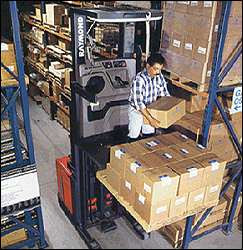Handling and storing materials involve diverse operations such as hoisting tons of steel with a crane; driving a truck loaded with concrete blocks; carrying bags or materials manually; and stacking palletized bricks or other materials such as drums, barrels, kegs, and lumber. The efficient handling and storing of materials are vital to industry.
In addition to raw materials, these operations provide a continuous flow of parts and assemblies through the workplace and ensure that materials are available when needed. Material handling equipment (MHE) is used for the movement and storage of material within a facility or at a site. MHE can be classified into the following five major categories:
- Transport Equipment. Equipment used to move material from one location to another (e.g., between workplaces, between a loading dock and a storage area, etc.). The major subcategories of transport equipment are conveyors, cranes, and industrial trucks. Material can also be transported manually using no equipment.
- Positioning Equipment. Equipment used to handle material at a single location so that it is in the correct position for subsequent handling, machining, transport, or storage. Unlike transport equipment, positioning equipment is usually used for handling at a single workplace. Material can also be positioned manually using no equipment.
- Unit Load Formation Equipment. Equipment used to restrict materials so that they maintain their integrity when handled a single load during transport and for storage. If materials are self-restraining (e.g., a single part or interlocking parts), then they can be formed into a unit load with no equipment.
- Storage Equipment. Equipment used for holding or buffering materials over a period of time. Some storage equipment may include the transport of materials (e.g., the S/R machines of an AS/RS, or storage carousels). If materials are block stacked directly on the floor, then no storage equipment is required.
- Identification and Control Equipment. Equipment used to collect and communicate the information that is used to coordinate the flow of materials within a facility and between a facility and its suppliers and customers. The identification of materials and associated control can be performed manually with no specialized equipment.
Did you Know? Traditionally, material-handling equipment may be grouped into 4 general categories and they are fixed-path system, the fixed area material handling system, variable-path variable-area equipment and the lastly the fourth category consist of all the auxiliary tools. In the first category (fixed-path system or also referred to as the continuous flow system) it consists of point-to-point equipments. This group of equipment serves the material handling need along a fixed path (like on a guided track).
The most common and familiar example of a fixed path system are trains and railroad tracks as trains can travel from any point to point, serving at any point that is along the track system. Other equipments under this category include the conveyor systems, powered, gravity-fed, automated guided vehicles and any other equipments that operate otherwise.
The second category is called the fixed area material handling system and this system can serve at any point within the three dimensional area or a cub. Examples such as the jib crane or the overhead traveling cranes can be installed on a floor pedestal to move parts and other material from any point to point in the x, y, z direction: however, this ability is limited within confines of the equipment. Automated storage and retrieval system (ASRS) also falls into this category.
AS for the third category, it consists of variable-material variable-area handling equipments or equipments that can move to any area of the facility.
Examples such as motorized vehicles, forklift trucks and all manual carts can be dragged, driven or pushed throughout the plant. Lastly, the fourth category consists of all auxiliary tools and equipments such as pallets, skids, automatic data collection systems, and containers Haha :)
That is all for our introduction to MHE. Although there is still much more categories of equipment in the industries, our group will be only focusing at the transport equipments and one of the positioning equipment which is the hoist for this assignment.
Hope that it stirs some interest in you!! Keep a lookout for more of our detailed findings to each of the equipments. Bye:)cya soon....













 Thus, the ergonomic challenge, then, is to position the operator relative to the truck to safely take advantage of this performance, yet avoid the musculoskeletal extremes of posture that lead to soft tissue damage and repetitive motion disorders.
Thus, the ergonomic challenge, then, is to position the operator relative to the truck to safely take advantage of this performance, yet avoid the musculoskeletal extremes of posture that lead to soft tissue damage and repetitive motion disorders.



























